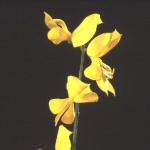| Common Name: |
Spanish Broom |
| Botanical Name: |
Spartium junceum |
| Genus: |
Spartium |
| Family: |
Fabaceae |
| Native Location: |
Mediterranean in southern Europe, southwest Asia and northwest Africa |
| Height: |
2-4 m (7-13 ft) |
| Width: |
5 cm (2 in) |
| Invasive Species: |
Spartium junceum has been widely introduced into other areas, and is regarded as a noxious invasive species in places with a Mediterranean climate such as California and Oregon, Hawaii, central Chile, southeastern Australia, the Western Cape in South Africa and the Canary Islands and Azores. It was first introduced to California as an ornamental plant. |
| Parts Used: |
Petals/Flowers |
| Chemical Constituents: |
Anagyrine
Cytisine
Methylcytisine
|
| Known Effects: |
Stimulates uterine contractions
Helps body dispose of excess fluid by increasing amount of urine produced
Stimulates gastrointestinal tract
Causes vomiting
|
| Possible Additional Effects: |
May induce labor
May cause watery, explosive bowel movements
|
| Uses: |
The plant is used as an ornamental plant in gardens and in landscape plantings. It has gained the Royal Horticultural Society's Award of Garden Merit.
In Bolivia and Peru, the plant is known as retama (not to be confused with the genus Retama) and has become very well established in some areas. It is one of the most common ornamental plants, often seen growing along sidewalks in La Paz.
Retama has made its way into the ethnobotany of the indigenous Aymara and Quechua cultures.
The plant is also used as a flavoring, and for its essential oil, known as genet absolute. Its fibers have been used for cloth and it produces a yellow dye. |
| Warnings and Precautions: |
Don't take if you:
Are pregnant, think you may be pregnant or plan pregnancy in the near future
Have any chronic disease of the gastrointestinal tract, such as stomach or duodenal ulcers, reflux esophagitis, ulcerative colitis, spastic colitis, diverticulosis, or diverticulitis
Consult your doctor if you:
Take this herb for any medical problem that doesn't improve in 2 weeks (There may be safer, more effective treatments.)
Take any medicinal drugs or herbs including aspirin, laxatives, cold and cough remedies, antacids, vitamins, minerals, amino acids, supplements, other prescription or non-prescription drugs
Pregnancy:
Dangers outweigh any possible benefits. Don't use.
Breastfeeding:
Dangers outweigh any possible benefits. Don't use.
Infants and Children:
Treating infants and children under 2 with any herbal preparation is hazardous
Others:
None are expected if you are beyond childhood, under 45, not pregnant, basically healthy, take it only for a short time and do not exceed manufacturer's recommended dose.
Storage:
Store in cool, dry area away from direct light, but don't freeze.
Store safely out of reach of children.
Don't store in bathroom medicine cabinet. Heat and moisture may change the action of the herb.
Safe Dosage:
Consult your doctor for the appropriate dose for your condition.
|
| Adverse Reactions, Side Effects, or Overdose Symptoms: |
| Signs and Symptoms |
What to Do |
|
| Diarrhea |
Discontinue. Call doctor immediately. |
| Kidney damage characterized by blood in urine, decreases urine flow, swelling of hands and feet |
Seek emergency treatment |
| Muscle Weakness |
Discontinue. Call doctor immediately. |
| Nausea or Vomiting |
Discontinue. Call doctor immediately. |
|
| Bibliography: |
From Wikipedia, the free encyclopedia-Article Spartium Junceum
Vitamins, Herbs, Minerals, & Supplements The Complete Guide by H. Winter Griffith, MD Copyright©1998 Fisher Books pp. 440-441 |

